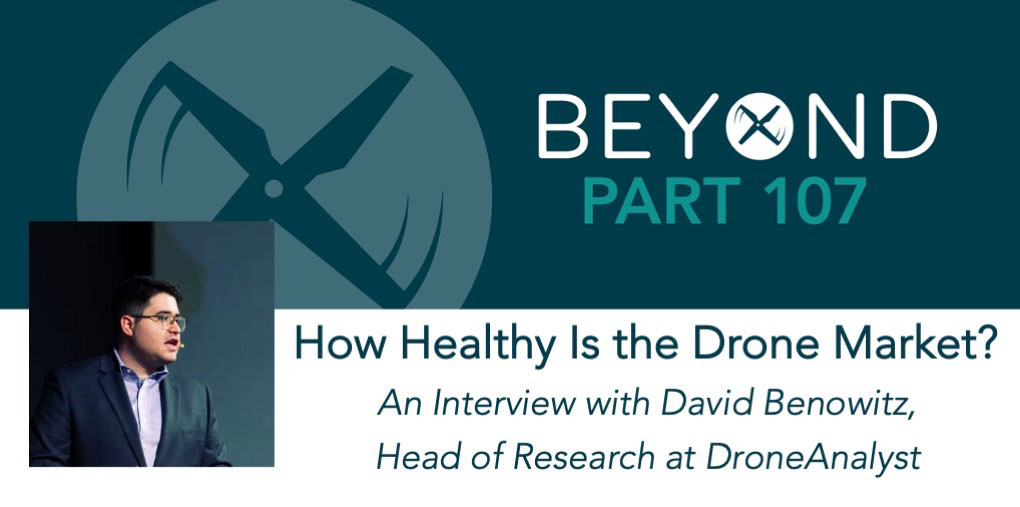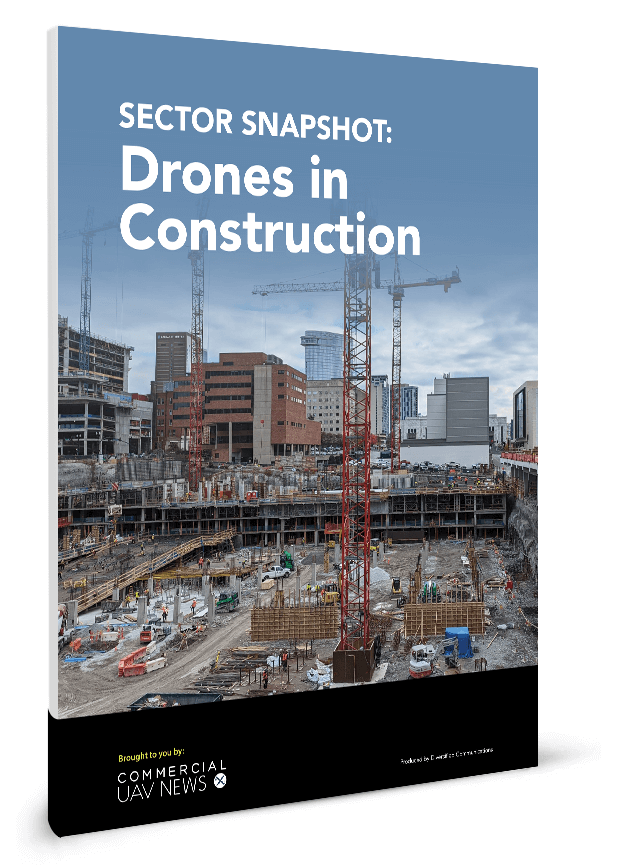While some reports have gotten caught up with the potential of the drone market, the team at Drone Analyst has always been committed to sorting out the hype versus the reality. Their fifth annual market report provides our most comprehensive look at drone buyers, service providers, business and public agency users, and software services.
David Benowitz is the Head of Research at DroneAnalyst. He laid out the key takeaways from this report, but Commercial UAV News Editorial Analyst Danielle Gagne wanted to further explore the insights as part of the Beyond Part 107 podcast. The two connected to dive into the health of the drone industry in 2021, what this year's report has to say about DJI's market share, how consolidation will take shape across the industry and much more.
The following is an abbreviated version of their discussion that has been edited for clarity by the Commercial UAV News team. You can listen to the whole episode here or download it via iTunes.
Danielle Gagne: Can you tell us about what you do and why you do it for anyone who may not be familiar with Drone Analyst?
David Benowitz: Drone Analyst is one of the first consulting and research agencies in the drone industry. We've been active since 2016, and we've always been focused on providing realistic analysis and insights into the drone industry and how it's performing. We work with stakeholders and brands to really understand their position in the market and where opportunities exist. Every year, we've released a big report that details market share data and contains tons of other valuable insights for drone industry stakeholders.
Danielle Gagne: You recently came out with the 2021 version of that report, so can you talk a little bit about how you compile those reports? What types of people in the industry do you look to have participate in them? And how do you process all of that information to deliver insights?
David Benowitz: This is our fifth annual report. It's the biggest one we've ever released, but what's in it is connected to our fundamental commitment to conducting industry-based surveys.
We had over 1,800 respondents this year. Those are mostly people in the drone services space as well as the people buying drones across numerous commercial segments. We take all of that data, analyze it and break it down by sector. We also interview key stakeholders and key users across each vertical. We've also started looking at critical data like public corporate financial data as well as things like Chinese customs data to really understand what the whole market is doing. We look at all of these elements from both the consumer and the commercial side since our data tends to be a little bit biased towards commercial. We want to be able to understand the whole spectrum.
Danielle Gagne: What were some of your key findings from this year's report?
David Benowitz: We had four key findings this year.
The first and probably the most exciting for the drone industry is that we're seeing a lot of revenue and a lot of spending from business and agency users. Both have really increased since we started running this survey and producing this report. Having more than 50% of drone programs now spending above 10K per year on their drone program is a big benchmark for the drone industry.
Secondly, we've seen really big shifts in the hardware market from the drone revenue side. DJI coming in at 54% is kind of a big drop. US companies are taking up a larger share of the drone market.
The third piece is related to how service providers are generating real revenue. Since we started creating these reports, we've seen that service provider revenue has been limited because so many people were jumping into the market. Now that a lot of people have exited the market and money is coming in, we're starting to see that revenue trickle up.
The last key finding is related to how the software market is now starting to mature. We're starting to see some consolidation specifically around Drone Deploy and Pix4D, but the drone fleet management software side of things is still a bit of an open game.
Danielle Gagne: I need to get a DJI question out of the way: in your opinion, how should the industry be looking at a drop in the commercial drone segment that Drone Analyst calculated at 74% as recently at 2018?
David Benowitz: Even if you're DJI you can see this as a great thing for the industry. There's just no way that one player having that much more than 50% market share is healthy for the industry. Some people might have qualms with the way that's happening, but when it's all said and done, this industry needs more competition. Those numbers prove that we're finally seeing it.
Autel is rising, but they're not really in second place. Skydio still has room to grow. And of course, all of that is after you consider the monopoly that DJI has with the consumer market for drones. Their consumer market share is above 94% when we look at all of the data. The bottom line is that we're finally starting to see competition on the commercial side and that's a really good thing. It should provide more space to grow in the years to come.
Danielle Gagne: It is really great to see that kind of competition because it makes you feel like it's anyone's game right now. But is that the reality? As you mentioned Autel has some great products but according to your report they're only at 7% and the technology from Skydio is just as exciting, but they're only at 4%. Those are some pretty small market shares. What does a healthy hardware drone market look like?
David Benowitz: We've never really had a healthy drone market. Which is part of why these developments are so exciting because I'm looking forward to seeing what that kind of healthy drone market looks like.
Personally, I think the drone market is always going to be somewhat fragmented. I don't necessarily see a big player coming in with a platform that could operate on every industry. I think DJI positioned itself as that in the early days but we're seeing the drawbacks of that approach on the developer support side. So I don't see that as the future for them.
We'll have different vendors for different applications, which might see a really targeted platform for each vertical. Maybe we'll get five to ten really healthy manufacturers, with one or two peeking out above the rest.
Danielle Gagne: How will any of those efficiencies or opportunities be defined by the kind of consolidation you hinted at earlier?
David Benowitz: Originally, the software you might purchase for your drone was focused on a single feature like flight ops or data processing. As these software brands have started to offer not just one of these features but many or all of them, they're getting squished together and treated the same. Two of the biggest ones we've seen this happen with are Drone Deploy and Pix4D. They both started as insights analytics companies but have pulled some many other features into their solutions. That's really where we see more consolidation happening.
Danielle Gagne: Do you think it is going to be more likely for open-source solutions to come into play than the kind of consolidation you mentioned?
David Benowitz: I see the inklings of that happening, but I don't think we're quite there yet, partly because there are some operators and organizations that are tied to certain hardware, especially if they're a US government entity or something at that level. What's interesting to see is how these companies navigate through an ecosystem that is changing before our eyes.
What's also been telling is the see the evolution of the blue sUAS drone program and how it's so focused on hardware and software that are quite integrated. I'm looking at how that can expand beyond drones and eventually into robotics.
Danielle Gagne: We're already seeing that kind of integration with the Boston Dynamics Spot robot, but is that more of an outlier? Is this kind of integration something you're going to be following?
David Benowitz: This year was actually the first time we asked about whether or not people were using other robotic systems. If they were, we asked about whether they were using a marine robotic system versus something ground-based. We found a lot of appetite and a lot of crossover.
When we asked this question about whether or not someone was considering purchasing another unmanned system in another domain, nearly 40% of all drone programs said that they were. Quite a few of them have actually gone through and made purchase. So that's quite exciting.
What's also telling is how these users are positioning the technology. Many that have setup a drone program have it structured underneath their robotics domain. And so in that way, they can see where all of this is eventually going. They already see how drones can plug into their ecosystems and programs to carry out jobs and tasks because they don't see drones as a robot, even though, you know, it is a flying robot.
Danielle Gagne: Was there anything that surprised you about the data? If you think about where we were a few years ago, is this where you thought we'd be today?
David Benowitz: There were a lot of things that surprised me. But the one especially surprising thing that also made me happy was seeing the revenue jump for service providers.
Every time we looked at the data, that was the one thing I pointed to as the thing that needed to grow. It's really rewarding to see those that have stayed and put in the work to train themselves and find their niche in the industry are starting to see those revenues. It's a great sign.
Danielle Gagne: Agreed, and there are a lot of service providers in our audience, so what can you tell them about the new potential or stability that you're seeing in the market for them? Is there a certain vertical they should be focused on? Or is there a certain approach that service providers can now take?
David Benowitz: First off, it's for certain that people have exited this space, and when people exit you can charge more because there's less competition. So that's something to consider at the onset.
As this market originally took shape, a lot of the service providers were looking at this kind of work as a second or third career or something to do post-retirement, and that just pushes down prices. That's kind of faded away, so prices have naturally risen. At the same time, drone program spending is up. Organizations are more willing to spend money once they've seen the value and they've tested it out internally. They know what they can pay for it and they know it's worth it. So that's another key factor.
What we're also seeing is that people who have a specific skill set, like surveyors or anyone that supports a specific utility, are getting great traction. But all of this also takes time. If you're a first-year drone service provider, you can't expect to make too much money. But once you get to that three, four year mark, for those that make it there, the vast majority of them are doing pretty well for themselves.
That's partly why I always tell anyone looking to get into this to start small. Don't buy that $30K drone. Buy something much more affordable to get the skills, get the expertise and get the contacts. Maybe that needs to be a side gig at the beginning, but there's room and space to grow in this industry, no matter where you start.
Danielle Gagne: How should drone industry stakeholders use what's in your report to make decisions? Ultimately, who is that report built for?
David Benowitz: Service providers and anyone who has or wants to create a drone program should have a sense of the further value the report contains. Those new data points for service providers are really important, so we want to open those up as much as possible.
The report is also for investors and brands that are looking to assess their position in the industry. So if you're a software brand or hardware brand looking to understand who your competition is or who's buying your products and for what purpose, you're going to get a lot out of this report.
If you're a stakeholder in the drone industry, you're probably taking a sector-by-sector approach, so you need to know what the market share is sector-by-sector. Being able to define those specific details from the perspective of these different sectors is the approach we've taken with the analysis in this report. So if you're a stakeholder or brand or investor or just someone looking to understand what their opportunity might be in this space, then this report is for you.
Danielle Gagne: What are you looking forward to happen in 2022?
David Benowitz: I'm excited to see more unique drones. And just like everyone else in this industry, I'm excited to see how things change and move forward with drone regulation. I would love to see another New Year's surprise like we did with Remote ID in 2020.
The larger eVTOL airframes in the market are exciting, but I really have to go back to being excited about new airframe types that will enable new applications to better support use cases that create real value.
We'll eventually get to autonomous drones where the value will really be defined at scale, but these niche areas and specific applications are the first steps to getting us there, and that's what I'm focused on for 2022.












Comments